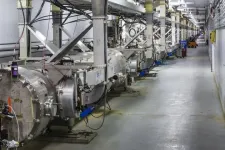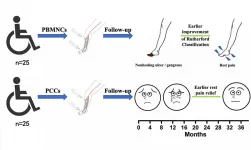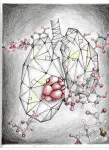Anticoagulants reduce the number of brain metastases in mice
2021-01-05
(Press-News.org) Brain metastases can only develop if cancer cells first exit the fine blood vessels and enter into the brain tissue. To facilitate this step, cancer cells influence blood clotting, as Heidelberg scientists from the German Cancer Research Center and from Heidelberg University Hospital have now been able to show in mice. The cancer cells actively promote the formation of clots, which helps them to arrest in the brain capillaries and then penetrate through the vessel wall. Drugs that inhibit the clotting factor thrombin were able to reduce the number of brain metastases in this experimental model.
Brain metastases are a feared complication of advanced cancers. Different cancers differ in their tendency to colonize the brain. Advanced-stage melanoma forms metastases in the brain in nearly half of all cases, and brain metastases are also very common in certain forms of breast cancer and lung cancer.
Brain metastases often cannot be removed surgically and frequently show no long-term response to treatments. "For patients with cancers that often spread to the brain, it would be extremely helpful if we had a treatment available that could prevent brain metastases from developing," explains Frank Winker, head of a research group at the German Cancer Research Center and managing senior physician at Heidelberg University Neurological Hospital.
It was already known from observational studies that antithrombotic drugs that inhibit blood clotting can have a favorable effect on the prognosis of certain cancers. It is possible that these agents influence metastasis. Winkler and his colleagues have now investigated in mice whether this also applies to brain metastases and, if so, how blood clotting and metastasis are linked. This study was made possible by a special microscopic technique (in vivo multiphoton laser-scanning microscopy) that allows the researchers to look deep into brain tissue and track individual cancer cells.
The mice were injected with melanoma or breast cancer cells into the bloodstream. Individuals of the circulating tumor cells then became arrested in the fine blood capillaries of the brain. Only if these cells now succeed in penetrating the vascular wall into the brain tissue can they grow into a brain metastasis. Winker and colleagues observed that blood clots (thrombi) frequently formed around the arrested tumor cells. Cancer cells around which no such clot formed did not manage to penetrate the capillary wall. "Apparently, the thrombus helps the cells hold on to the capillary for a long time in preparation for passage through the vessel wall," Winkler explains.
The Heidelberg researchers found that the tumor cells apparently intervene directly in the complex cascade of blood clotting and thus actively trigger the formation of the thrombi. They promote the formation of the clotting factor thrombin, which is required for the formation of the long-fiber protein fibrin, of which the network of the clot mainly consists.
Thrombus formation, the researchers realized, is the necessary prerequisite for tumor cells to leave the capillary and thus take the crucial first step toward forming a brain metastasis. An drug that inhibits thrombin would therefore have to suppress metastasis because it prevents the tumor cells from penetrating into the brain tissue. And indeed: mice that received the thrombin inhibitor dabigatran, which is already approved as a drug, developed significantly fewer metastases than untreated animals.
Inhibition of another blood clotting factor (von Willebrand factor) with specific antibodies also reduced the formation of thrombi in the mice - and subsequently the number of brain metastases that developed.
"These experiments show that it is primarily the influence of the cancer cells on the plasmatic coagulation factors that promotes the development of brain metastases. This is why a preventive drug should target precisely this process," explains Manuel Feinauer, first author of the current publication.
"Our goal is to identify drugs for the prevention of brain metastases in high-risk patients," says Winkler. "The studies in mice are a first step toward understanding exactly how theses substances can prevent tumor cells from colonizing the brain. In the long term, we then want to test these substances in clinical trials. To do this, we first need to better understand for which cancer subtypes this mechanism is particularly important, and also whether we can even better identify patients with a particularly high risk of brain metastases."
The researchers are optimistic because the drugs that inhibit thrombin have at least one already known advantage: they have long been prescribed for the prevention of strokes and are therefore considered to be comparatively well tolerated, even over long periods of time.
INFORMATION:
Manuel J. Feinauer, Stefan Werner Schneider, Anna S. Berghoff, Jose Ramon Robador, Cedric Tehranian, Matthia A. Karreman, Varun Venkataramani, Gergely Solecki, Julia Katharina Grosch, Katharina Gunkel, Bogdana Kovalchuk, Frank Thomas Mayer, Manuel Fischer, Michael O. Breckwoldt, Maik Brune, Yannick Schwab, Wolfgang Wick, Alexander Thomas Bauer and Frank Winkler: Local blood coagulation drives cancer cell arrest and brain metastasis in a mouse model
Blood 2020, DOI: 10.1182/blood.2020005710
Das Deutsche Krebsforschungszentrum (DKFZ) ist mit mehr als 3.000 Mitarbeiterinnen und Mitarbeitern die größte biomedizinische Forschungseinrichtung in Deutschland. Über 1.300 Wissenschaftlerinnen und Wissenschaftler erforschen im DKFZ, wie Krebs entsteht, erfassen Krebsrisikofaktoren und suchen nach neuen Strategien, die verhindern, dass Menschen an Krebs erkranken. Sie entwickeln neue Methoden, mit denen Tumoren präziser diagnostiziert und Krebspatienten erfolgreicher behandelt werden können.
Beim Krebsinformationsdienst (KID) des DKFZ erhalten Betroffene, interessierte Bürger und Fachkreise individuelle Antworten auf alle Fragen zum Thema Krebs.
Gemeinsam mit Partnern aus den Universitätskliniken betreibt das DKFZ das Nationale Centrum für Tumorerkrankungen (NCT) an den Standorten Heidelberg und Dresden, in Heidelberg außerdem das Hopp-Kindertumorzentrum KiTZ. Im Deutschen Konsortium für Translationale Krebsforschung (DKTK), einem der sechs Deutschen Zentren für Gesundheitsforschung, unterhält das DKFZ Translationszentren an sieben universitären Partnerstandorten. Die Verbindung von exzellenter Hochschulmedizin mit der hochkarätigen Forschung eines Helmholtz-Zentrums an den NCT- und den DKTK-Standorten ist ein wichtiger Beitrag, um vielversprechende Ansätze aus der Krebsforschung in die Klinik zu übertragen und so die Chancen von Krebspatienten zu verbessern.
Das DKFZ wird zu 90 Prozent vom Bundesministerium für Bildung und Forschung und zu 10 Prozent vom Land Baden-Württemberg finanziert und ist Mitglied in der Helmholtz-Gemeinschaft Deutscher Forschungszentren.
ELSE PRESS RELEASES FROM THIS DATE:
2021-01-05
A recent study finds that, while youth think all bullying is bad, non-immigrant adolescents object less to bullying when the victim is an immigrant. However, the study found that the more contact immigrant and non-immigrant children had with each other, the more strongly they objected to bullying.
"We know that bystanders can play a key role in stopping bullying, and wanted to better understand bystander responses to bias-based bullying," says Seçil Gönülta?, first author of the study and a Ph.D. student at North Carolina State University. "What role does a victim's background play? What role does the bystander's background play? Are children more or less likely to intervene if they come from different backgrounds?"
To explore these questions, the researchers ...
2021-01-05
BOSTON - Findings from the Nurses' Health Study, one of the longest running studies of women's health, show that five diet and lifestyle factors, including regular exercise, can make a significant impact on gastroesophageal reflux (GERD) or heartburn symptoms. GERD is a common condition, affecting about a third of the U.S. population; the main symptom is heartburn and it is often managed with medications. This new study suggests, however, that following diet and lifestyle guidelines may reduce symptoms substantially and could make medication unnecessary for some patients. It was published as a letter in JAMA Internal Medicine.
The five factors include normal weight, never smoking, moderate-to-vigorous physical activity for at least 30 minutes daily, restricting coffee, tea ...
2021-01-05
Microscopy -- Nanoscale commuting
Oak Ridge National Laboratory's Center for Nanophase Materials Sciences, or CNMS, contributed to a groundbreaking experiment published in Science that tracks the real-time transport of individual molecules.
A team led by the University of Graz, Austria, used unique four-probe scanning tunneling microscopy, or STM, to move a single molecule between two independent probes and observe it disappear from one point and instantaneously reappear at the other.
The STM, made available via the CNMS user program, operates under an applied voltage, scanning material ...
2021-01-05
Five years after the Paris climate agreement, all eyes are on the world's progress on the road to a carbon-free future. A crucial part of this goal involves the energy transition from fossil fuels to renewable sources, such as sun, water, wind and wave energy. Among those, solar energy has always held the highest hope in the scientific community, as the most reliable and abundant energy source on Earth. In recent decades, solar cells have become cheaper, more efficient, and environment friendly. However, current solar cells tend to be opaque, which prevents their wider use and integration into everyday materials, constrained to being lined up on roofs and in remote solar farms.
But ...
2021-01-05
Operators of the primary particle accelerator at the U.S. Department of Energy's Thomas Jefferson National Accelerator Facility are getting a new tool to help them quickly address issues that can prevent it from running smoothly. A new machine learning system has passed its first two-week test, correctly identifying glitchy accelerator components and the type of glitches they're experiencing in near-real-time.
An analysis of the results of the first field test of the custom-built machine learning system was recently published in Physical Review Accelerators and Beams.
The Continuous Electron Beam Accelerator Facility, ...
2021-01-05
Microorganisms are the most abundant and diverse form of life on Earth. However, the vast majority of them remain unknown. Indeed, only a small fraction of the microorganisms of our planet can be cultured under traditional conditions, leaving a world of unculturable organisms out of our scope. This is especially true for bacteria thriving under extreme conditions as the harsh conditions are hardly reproducible in a lab. While some microbial studies have been performed in the Sahara, the Atacama, and the Gibson desert, European arid lands remain poorly studied.
To finally explore the microbial community of some European deserts, researchers ...
2021-01-05
An effective response to a pandemic like the COVID-19 will only be successful if people voluntarily follow the rules and guidelines of decision-makers and experts. Many of the required measures, such as avoiding social contact and significantly changing our daily habits require a strong commitment. Other necessary actions, such as regular hand washing, are often impossible to monitor and enforce. Adherence to the guidelines thus depends on people's personal commitment.
The ability of policy makers and experts to communicate convincingly to citizens has a strong influence on whether ...
2021-01-05
CORVALLIS, Ore. - Co-developing land for both solar photovoltaic power and agriculture could provide 20% of total electricity generation in the United States with an investment of less than 1% of the annual U.S. budget, a new paper by Oregon State University researchers found.
Wide-scale installation of agrivoltaic systems could lead to an annual reduction of 330,000 tons of carbon dioxide emissions in the U.S - the equivalent of 75,000 cars off the road per year - and the creation of more than 100,000 jobs in rural communities, while minimally impacting crop yield, the researchers say.
"Agrivoltaics provide a rare chance for true synergy: more food, more energy, lower water demand, lower carbon emissions, and more prosperous rural communities," said Chad Higgins, an associate ...
2021-01-05
Durham, NC - Mid-term results of the first clinical trial designed specifically to evaluate the safety and effectiveness of two cell therapies that are showing early promise in treating angiitis-induced critical limb ischemia were released today in STEM CELLS Translational Medicine. The study, by researchers at Zhongshan Hospital/Fudan University in Shanghai, compared how transplantation of peripheral blood mononuclear cells fared versus transplantation of purified CD34+ cells in treating this condition.
It revealed both therapies yielded satisfactory results and provided evidence for ...
2021-01-05
DALLAS - Jan. 5, 2021 - Researchers at the Children's Medical Center Research Institute at UT Southwestern (CRI) have discovered a new metabolic vulnerability in a highly aggressive form of non-small cell lung cancer (NSCLC). These findings could pave the way for new treatments for patients with mutations in two key genes - KRAS and LKB1. Patients whose tumors contain both of these mutations, known as KL tumors, have poor outcomes and usually do not respond to immunotherapy.
"We used to think that most tumors rely on the same handful of metabolic pathways to grow, but we've learned over the last decade that this is an oversimplification. Instead, different tumor subclasses have particular metabolic needs arising from mutations ...
LAST 30 PRESS RELEASES:
[Press-News.org] Anticoagulants reduce the number of brain metastases in mice




